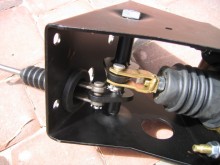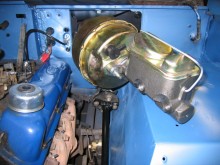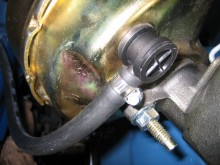Recently I installed the "No Modify" Power Brake Kit
from Tom's Bronco Parts and have been very happy with the results. In addition
to being a nice kit, what really sold me was the fact that the booster design
fits with no fender modification.
The kit was very complete and the install went smoothly. It probably would have
taken less than a day if I hadn't detoured to clean up my engine bay. The new
pedal feel admittedly took me a while to get used to. I've been driving my 72
Bronco with non-power brakes for more than 10 years. But now that I'm used to it
I really enjoy driving the truck more. The braking feels more secure and
requires very little pedal effort.
Tom's Power Brake Kit



Above are photos of the kit as shipped. Included is the booster, bracket, master cylinder, master cylinder brake lines, adjustable pushrod with rubber seal and vacuum hose with clamps.



Prepare the booster bracket:
Install the new rubber seal/bellows that the pedal rod goes through, then the pedal rod. Thread the adjuster nut and connection fork onto the new pedal rod.
At this point don't worry about how far to thread the fork. This will be
adjusted later. Connect the fork to the bell crank (pivot bar) on the bracket using the supplied pivot pin, but don't put the cotter pin in just yet.
Installation


Removal of old master cylinder:
Start by removing the brake lines that go from the master cylinder down to the distribution block (also called an "H block" or "pressure differential switch") If you have a 76-77 Bronco you should have a proportioning valve
instead of the distribution block found on earlier models. After removing the brake lines plug them to avoid air and moisture getting into your brake system.
Take a measurement of the brake pedal height from the floor board. You'll need
this later when adjusting the new connecting rod. Now, from under the dash disconnect the rod at the brake pedal. Save the clip and any bushings. Now unbolt the master cylinder from the firewall. The new booster bracket uses one of the master cylinder bolt holes as well as 3 others. You'll need to remove those three bolts. See the arrows on the photo above. Now is a good time to clean and repaint your firewall if it needs it.
Install the booster:
Place the booster against the firewall and secure with the 4 bolts. Now
adjust the length of the pedal-to-booster connecting rod so that your brake
pedal is at the same height it was previously. Tighten the lock nut to secure
the rod fork. Then reconnect the rod fork to the booster bracket arm with the
supplied pivot pin. Be sure to secure with a cotter pin.
Bolt up the master cylinder:
Before bolting the master cylinder to the booster you need to adjust the length
of the push rod sticking out of the booster. According to Tom's there should be about 1/16" of play before
the push rod engages the master cylinder. To get this play start by threading the tip of the push rod out
until the master cylinder no longer pushes up snub against the booster. Then
thread the tip in just enough so the master cylinder just
slides up to the booster without pushing on the rod. This will be your point of
no play. Now take the master
cylinder off and thread the tip of the rod in 1/16". Bolt the master
cylinder to the booster.


Bench Bleeding:
You should always bleed the master cylinder to get rid of any air. Air in the master
cylinder will go straight into the brake lines and make it that much harder to
bleed the system afterwards. This is called "bench bleeding" although you can do
it on your bench or attached to the vehicle. Pick up a simple kit from your
local parts store, which will include various size fittings and 2 rubber lines.
Thread the fittings into the master cylinder, attach the tubes and loop them back into
each reservoir. (You can avoid buying this kit if you don't mine destroying your
old master cylinder hard lines. Just cut them and bend them back into the
reservoirs
like this.)
Next fill each reservoir with brake fluid to about 1/2" from the top.
Don't overfill. Make sure the tubes are secure (tape them to the MC if you have
to) and SLOWLY pump the brake pedal. (If you are bench bleeding us a large screw
driver to push on the master cylinder) Keep an eye on the brake fluid level and
add fluid as needed to be sure the tubes stay submerged. When you stop seeing
bubbles the bleeding is done. Brake fluid is almost as bad as paint remover. You
may want to lay a rag under your master cylinder while bleeding to avoid
spilling any fluid onto painted surfaces.
Install Brake Lines:
Now it's time to attach the brake lines from the master cylinder to the H-block
(or distribution block). The H-block shown is the most common configuration on
drum brake Broncos and is always confused with a proportioning valve. This IS
NOT a proportioning valve. It's only a junction for the brake lines, which also
serves as a brake warning light switch. It wasn't until 1976-77 that Broncos
came stock with proportioning valves.
Here's a photo.
I highly recommend getting new brake lines. The set I got from Tom's fit
perfectly and made the install simple. If you need to adjust them be very careful not to crimp or make any
sharp bends. Always use flare wrenches when working with brake line fittings.
Normal open end wrenches can round off the corners. Don't use teflon tape on
brake line threads. Brake lines seal using the flared seat at the end of the
lines, not the threads. If you have a leak it's because the seat isn't sealing
properly, not because fluid is getting past your threads.




Hook up the vacuum:
Attach the supplied vacuum hose to the check valve at the booster. Attach the
other end of the hose to a vacuum source, either on the intake manifold (shown)
or at the base of the carburetor. Be sure to route the vacuum hose away from
exhaust/headers and steering components.
Attach brake pedal:
Now climb under the dash and reattach the brake pedal and switch to the push
rod. Use your old clip (check that it's in good shape) and any bushings you took
off originally. Be sure to check that your brake lights go on when you step on
the pedal. Note the cheesy wiring fix done by a previous owner who was too lazy
to find the correct factory plug. Of course I've now owned the truck longer than
he did and I still haven't fixed it!
Final Inspection and test drive:
Check and double check all brake line fittings to be sure none are leaking.
Check that you filled the master cylinder after bleeding and the cap is secure.
Check your brake pedal is securely attached to the rod. Check that the pedal
operates smoothly with no binding or loose feel. Did I mention to check
everything again? Remember, these are your brakes you're dealing with. It
doesn't get much more important than that.
Take it for a SLOW test drive around the block. Give yourself some time to get
used to the different feel and how quickly it brakes. Once you're sure
everything is safe and working properly go have fun!

Rear drum adjustment:
My first few test drives resulted in some strange behavior. The stopping power
was there, but seemed to come on all at once. The first 2" of pedal travel was
very easy and didn't brake very hard. Then the next 1/2" brought the truck to a
halt. A quick call to Tom's Bronco Parts suggested it was probably my rear brake
shoes needing adjustment. Apparently this is pretty common. If the rear shoes
aren't adjusted properly they take too long to kick in resulting in a lurching
stop.
Remove the tire and brake drum. This is a great time to inspect, clean and
replace any needed parts or shoes. Adjust the "self adjusting" star wheel so
that the brake shoes spread out. Adjust as needed until the drum just barely
fits back on, but doesn't drag when you turn it by hand. If you're confident
that your drums are in good shape then you can adjust the shoes without taking
off the wheels. Use a flat screw driver (or adjustment tool) through the access
hole in the backing plate. Pry the wheel from bottom to top to tighten. Looking
from the back of the truck the drivers star wheel goes counter clockwise and the
passengers goes clockwise.
For tech questions or install problems please contact:
Tom's Bronco Parts
2294 Sage Rd.
Medford, OR 97501
(541) 779-1339
info@tomsbroncoparts.com
Product Review by Jon Hanna (Admin)



